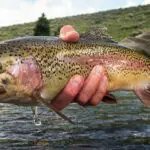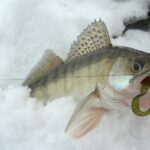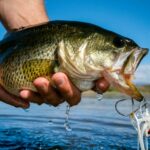The humble fishing swivel may seem insignificant, but it can significantly impact your next fishing trip. In certain conditions, a swivel can help you to present your bait as naturally as possible, eliminating line twists so your bait looks enticing to passing fish.
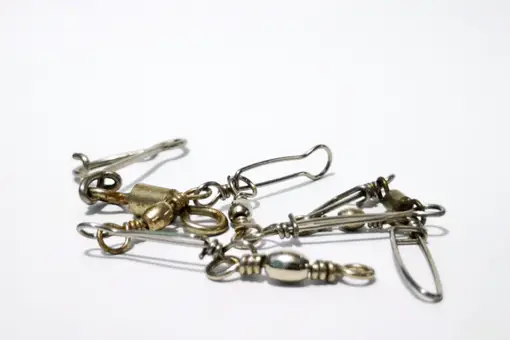
Today, we’re going to cover everything you need to know about different types of fishing swivels, how they’re used, and what swivels you should pack for your next fishing trip.
What Is a Fishing Swivel?
Fishing swivels, sometimes called line connectors, are small pieces of terminal tackle that spin freely from a center point, allowing the leader and lure or bait to rotate independently of the main line, preventing line twists.
Swivels feature a ring on either side, with a central pivot point that allows the swivel to spin freely on the line. The main line connects to the first ring, and the leader is attached to the second one. When fishing offshore or in heavy currents, the swivel can spin freely, which prevents the line from becoming twisted.
The highest quality swivels are made from stainless steel, while more budget-friendly options are made from brass.
Seven Different Types of Fishing Swivels
While swivels all serve the same primary purpose, there are many different types of fishing swivels to suit different situations.
Ball Bearing Swivels

Ball bearing swivels are the most popular and effective style of swivel, and they’re versatile enough to handle virtually any fishing scenario.
Ball bearing swivels feature ball bearings at either side, allowing the swivel to move freely, preventing line twists as it moves. While you’ll find some cheaper brass swivels in smaller sizes, most ball-bearing swivels are made from stainless steel.
These swivels are made in the broadest range of sizes, so ball-bearing swivels are an excellent option for fishing offshore when larger and heavier swivels are necessary to handle pelagic species.
The only drawback of ball-bearing swivels is that they’re significantly more expensive than other types. If you go through a lot of terminal tackle, ball-bearing swivels may end up costing you an arm and a leg.
Barrel Swivels

Before the invention of ball-bearing swivels, barrel swivels ruled the land. These swivels are a bit more primitive, lacking the ball bearings that help other swivels spin more freely. Still, they’re an excellent choice for joining different types of lines, and they’re inexpensive.
Barrel swivels are typically made from nickel-plated brass coated in black paint, and they have a stealthy look that makes it more difficult for fish to detect the swivel.
These swivels don’t spin as well, and under heavy load, they hardly spin at all. In situations where line twist is a concern, barrel swivels often don’t spin freely enough to prevent line twist.
When fishing light tackle or when the primary purpose of the swivel is to join lines without a line-to-line knot, barrel swivels are an excellent choice at an affordable price. For heavy-duty applications, opt for one of the different types of fishing swivels.
Crane Swivels

Crane swivels look virtually identical to barrel swivels but with slight differences affecting their usefulness.
It’s nearly impossible to tell a crane and barrel swivel apart until you spin them. Crane swivels have an internal pivot point instead of an external one, and they spin more freely when under load, which makes them useful when targeting larger fish.
Crane swivels are more expensive than barrel swivels but still cheaper than ball-bearing swivels, so they’re a wise choice for the angler who demands high performance on a budget.
Extreme Swivels

Extreme or Aussie-style swivels are made for the most demanding fishing applications. They were developed by Australian anglers who regularly target large fish weighing hundreds of pounds or more.
These swivels come in various sizes and styles, but what differentiates them from other swivels is how and what they’re made from. Extreme swivels are made from high-grade stainless steel and heavier gauge wire to withstand the demands of offshore fishing.
The most common Aussie-style swivels feature two pieces of stainless steel with a hole in each side, either for attaching line or stainless steel split rings. These swivels have internal ball bearings for smoothness and to prevent line twists, and they’re rated to handle 250 pounds or more. You’ll also find Aussie-style snap swivels, which feature heavy-duty offshore-style snaps.
Finesse Swivels

SPRO introduced finesse or power swivels to provide finesse anglers with the strongest, smallest, and lightest terminal gear possible. These swivels offer remarkable strength for their size and are an ideal choice for virtually all fishing styles.
Finesse swivels are essentially crane swivels made from stainless steel with heavy gauge wire, and they’re much smaller than traditional barrel swivels without sacrificing strength or performance. Some finesse swivels are so tiny that they can pass through rod guides without becoming trapped or damaging the eyelets.
Finesse swivels are most popular with freshwater anglers who need the stealthiest presentation possible and offshore trolling anglers, as the low profile of the swivels allows you to bring the swivel through the rod eyes without damaging them.
Rolling Swivels
As you shop the different types of fishing swivels, you’ll come across rolling swivels, which are the same as barrel swivels. These two names are used interchangeably by various manufacturers, but the two designs are identical.
Rolling swivels have an external pivot point, function poorly under heavy loads, and are best used to join two lines together when line twist isn’t a concern.
Snap Swivels

Snap swivels are an excellent piece of terminal tackle that helps attach lures to your line or an entire leader setup to your main line. These swivels have a snap clip on one side of the swivel, so you can quickly connect or remove lures. You can also tie a surgeon’s loop at the end of your leader and attach that to the clip so you can easily change leaders.
Snap swivels are usually barrel swivels with an interlock, coast lock, or duo-lock snap attached to one end. You’ll also find snap swivels with ball bearings or Aussie-style swivels for the most demanding applications.
How To Decide Which Fishing Swivel to Use
When you’re on the water, there are a few things you’ll want to consider as you reach for your next swivel.
Colors
Most swivels come in three colors: silver, black, or brass. While anglers will debate until the cows come home which color is most effective, there’s no reason to believe the color of your swivel impacts how well you’ll do on the water that day.
There is one crucial thing to consider regarding the color of a brass swivel. The process of coloring a brass swivel black involves overlaying a small amount of copper onto the swivel and putting it in a salt bath so the copper oxidizes and turns black.
This process will eat away at the brass underneath, weakening the swivel over time, especially as it’s exposed to salt water. If you prefer black swivels, try to opt for a stainless steel model, as they’re significantly more robust than black brass swivels.
Materials
Fishing swivels are made from either stainless steel or nickel-plated brass. While both materials can produce swivels of excellent quality, the differences between these materials become more evident when targeting larger fish.
Stainless steel is significantly more durable than brass, so it’s the best choice for the most demanding applications. Any time you’re targeting fish over twenty pounds, you’ll want to use stainless steel over brass. For freshwater fishing and light tackle saltwater fishing, brass swivels are as functional as stainless steel.
Weight and Size
A critical consideration you need to make when selecting fishing swivels is the size. Swivels are sized similarly to hooks, with sizes ranging from 14 at the smallest end of the spectrum, which is about 6mm, to 12/0, which is nearly 60mm. Swivel sizes also correspond to the load that the swivel can bear.
The largest swivels can handle loads upwards of 1,000 pounds, while the swivels at the smaller end of the spectrum can handle 5-10 pounds. When purchasing swivels, always select ones that can hold an appropriate amount of weight for the fishing you’ll be doing. If the size is a concern, purchase ball bearing swivels or finesse swivels, which have a much higher size-to-weight ratio.
Conditions
When selecting a swivel, you’ll always want to consider the type of fishing you’re doing. Trolling for tuna or other pelagics will require heavy-duty stainless steel swivels that spin freely. Meanwhile, the type of swivel you use is less critical if you’re fishing your local lake for panfish or small bass.
How to Care for a Fishing Swivel
Swivels are such a seemingly minor piece of terminal tackle that most anglers overlook the essential maintenance required to keep them in top shape. It only takes a few seconds to care for your swivels, so get into the habit of cleaning them properly after each fishing trip.
After each trip, you need to properly care for your swivels and rinse them thoroughly in fresh water. A quick rinse removes residual salt from the swivels, which can oxidize and weaken the metal over time.
How To Connect a Fishing Swivel to a Lure
Joining lines with a swivel is easy, provided you know a few essential knots.
The first knot you’ll want to know about is an improved clinch knot. This versatile knot has many uses, and it’s a go-to knot for securing swivels, hooks, or lures. Here’s how to tie the improved clinch knot.
- Thread the line through the eye of the swivel and bring the line up and parallel to the standing line
- Cross the tag end over the standing line, and wrap the tag end around the line 5-10 times
- Pass the tag end through the small loop behind the eye of the hook
- Pass the tag end through the large loop above the small loop
- Pull the tag end gently to begin forming the knot
- Moisten the knot with saliva
- Continue pulling on the tag end to finish developing the knot
- Pull the main line to finish cinching the knot down
Another excellent knot for attaching terminal tackle to your line is the Trilene knot.
- Pass the tag end of the line through your swivel eye and then once more through the hook eye to form a loop
- Take the tag end and wrap it around the standing line 4-5 times
- Pass the tag end through the loop you created in the first step
- Pull the main line to cinch the knot down against the swivel
Frequently Asked Questions
As anglers learn more about the different types of fishing swivels, they usually have a few related questions. We’ve rounded up the answers below so you can find all the necessary information in one place.
When should I replace a fishing swivel?
You should replace your swivel when it becomes severely oxidized (in the case of brass swivels) or if the swivel isn’t spinning correctly. If the swivel looks good and spins freely, you’re good to keep fishing.
Can I use snaps instead of fishing swivels?
Snaps make it easy to change lures or entire leaders when you’re on the water. In some applications, you can use a snap in place of swivels; but snaps don’t spin as swivels do, so they won’t address line twist.
Do swivels add a point of weakness to a fishing line?
Yes, any piece of terminal tackle, such as a swivel, will add a weak point to your fishing line. Any time you tie a knot or join two lines together, you’re introducing a point of weakness to the line. So while a swivel will create a weak point, there’s no way to avoid it since a line-to-line knot would create the same weak point as a swivel.
Conclusion
Fishing swivels may seem like an afterthought, but this tiny piece of terminal tackle can save you tons of headaches on the water. When you’re on your next fishing trip, consider the conditions you’re fishing, and if it calls for one, use one of the different types of fishing swivels that best suit your needs when rigging up.
- Do You Need An Indicator For Nymph Fishing? - November 16, 2023
- Fishing Safety Tips For Families - September 25, 2023
- What Is The Best Time To Night Fish At A Lake? - September 18, 2023




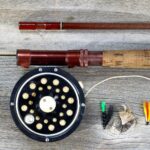

![Kayak Fishing for Beginners [10 Tips for a Successful Trip] fishing kayak moored on a beach](https://irvinelake.net/wp-content/uploads/2022/12/kayak-fishing-for-beginners-150x150.png)
